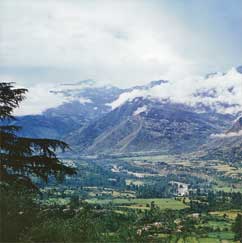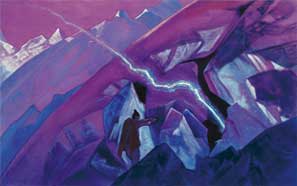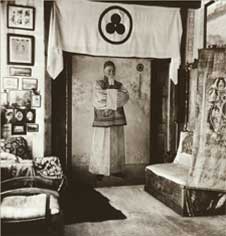| printer friendly | |||
|
|||
 | |
| Kullu Valley. Photograph by L. Shaposhnikova |
The hall of Kullu transfers us to a wonderful valley of India where 20 years of N. Roerich’s life passed, where the first in the world Institute of Himalayan Studies was founded.
The Valley of Kullu lies in the Himalayas Western spurs, in the middle of magnificent snowy mountains. They are soaring up like inaccessible guards on Nicholas and Svetoslav Roerichs’ paintings and on L. Shaposhnikova’s photographs, concealing from strangers’ eyes sacred Kuluta, its subtle beauty, its unsolved mystery.
“It is called the Silver Valley, N. Roerich wrote. – Be it in winter, when the snow is sparkling, or in spring, when all fruit trees are covered with snowy-white flowers, the valley equally well deserves its name”1.
The history itself sounded in the valley of Kullu. It sounded with legends and myths, ancient chronicles and epic poems. “In these areas, rishis and wizards of India lived, Nicholas Roerich noted. – Many legendary and historical events are related to these uplands. Buddha passed here, and dozens of Buddhist monasteries flourished at their time. <…> here, Rishi Vyasa put together Mahabharata. This is the Viaskund too – the place where wishes come true”2. In Badjuara, near the river Beas, there is a temple having relation to the name of Gesser-Khan. Having come from Ladakh direction, the great hero overtook his enemies and conquered them. On this same river Beas, Alexander the Great stopped. Here, there are the ruins of the Pandavas’ palaces, Arjuna’s cave.
 | |
| N. Roerich. Arjuna. From the “Kullu” series. 1928 – 1930 |
Names of historical persons got confused with characters from poems, names of wizards –Rishis – could be guessed in the names of 360 gods of the valley. People told legends about Rishis, Great Souls, and gods, and asserted that from time to time they saw them, and that Rishies and the gods interfered in their lives. Many people saw how the gods travel. Sometimes they fly, sometimes move with huge leaps, leaning on sticks. The gods visit each other. In the temple store-rooms, there are rich clothes, pearls, gold, silver masks – the gods’ attributes.
Fairy-tales interwove with reality. “Rishies lived not in the legend, but in reality. Their presence revives the rocks crowned with glaciers, and emerald pastures of yaks, and the caves, and roaring streams. From here they sent spiritual appeals about which the mankind remembers through all centuries. They learn them at schools, translate to various languages, but the crystal of their accumulations grew stratifying on the Himalayan rocks”3 (N. Roerich).
The valley amazed with its miracles. On the tops, near the very snows, there were ruins of castles and towers. Goddess Tripurasundari smiled mysteriously from a stone plate with a trident in her hand. On the rocks, ancient bowmen’s arrows overtook tough-horned goats. Through Kuluta, ancient caravan ways went to Tibet, China, valleys of India. Along these ways, settlers once moved along, waves of conquerors swept past. All of them contributed something into the valley’s life and culture. But its ancient heritage remained unchanged – the snowy ridges kept a keen eye on it.
Here, to the valley of Kullu, along the road winding amidst the rocks, a caravan arrived at the end of 1928. It carried the load of the Central-Asian expedition: natural scientific collections, ancient manuscripts, darkened with time Tibetan bronze, tankas (Buddhist icons on cloth) painted by artists a few centuries ago, N. Roerich’s canvases.
 |  | ||
| Interior … | and facade of the Roerichs’ house in Kullu.
1920 – 1940s. |
Nicholas Roerich with his wife and sons saw it for the first time on an early frosty morning. Nobody lived in the two-storey building. The guard, and old Indian, showed them to the garden and to the house. Massive wooden chairs with high backs were standing around a long oak table in the dining-room. Initials “H.R.” were carved on the backs. A feeling of something extraordinary, fairytale appeared. “H.R.” – Helena Roerich – as if the house was meant for her.
Later, it was found out that the house was built as long ago as in the last century by an English Colonel Henry Rennick. “H.R.” were the Colonel’s initials. But the feeling of some secret sign contained in those letters remained.
Nicholas Roerich bought the house they liked. Here, above a mountain village of Naggar, he settled down with his family.
|
|
||
|
||
